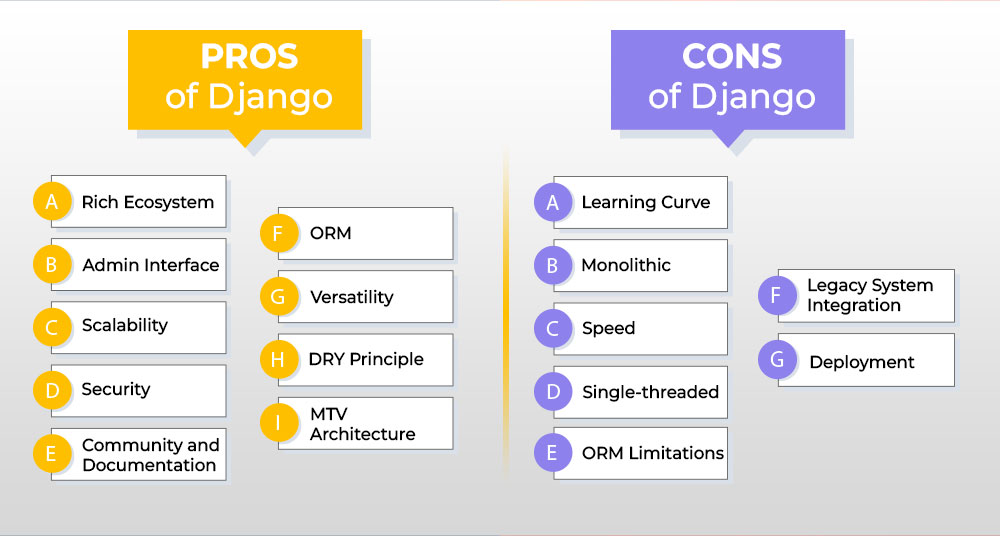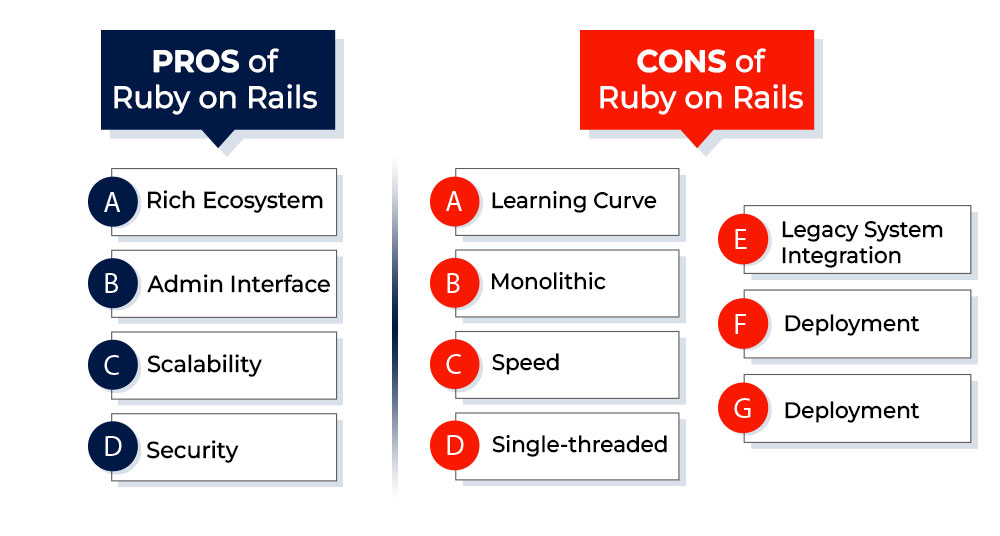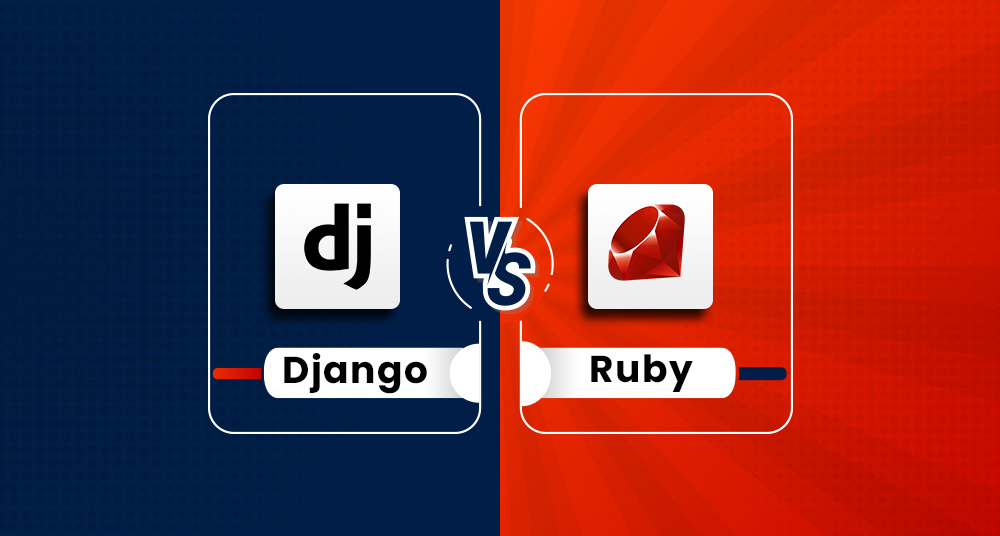Introduction
Backend development is vital, and many people wish to learn about backend development. While different technologies can make backend development possible, one must choose the right framework for getting the job done.
Django and Ruby on Rails are the two popular frameworks used for backend web development. Each of these frameworks has unique features and certain benefits and drawbacks.
In this article, we will see comparison on Django vs Ruby on Rails to help you decide which is better for your backend web development needs in the year 2025.
What is Django?
Django is a high-level Python web framework that encourages rapid development and clean, pragmatic design. It follows a principle called “DRY”. The word “DRY” stands for Don’t Repeat Yourself. This principle focuses on the reusability and pluggability of components. Django is known for its built-in features for everything from authentication to URL routing. This makes it a versatile choice for developers.

Pros of Django:
Here are some benefits of Django –
- Rich Ecosystem: Django has a huge array of reusable apps, libraries, plugins, and others, which can help speed up the development process.
- Admin Interface: You get an automatic, built-in admin interface for managing the application data. All of this can help save time.
- Scalability: Django is quite scalable. This makes it suitable for small and large applications. This can handle high levels of user traffic as well as interaction.
- Security: Developers can avoid security mistakes like cross-site scripting SQL injection, as Django has robust built-in security features.
- Community and Documentation: Django has a very strong community that follows well-organized documentation and makes it easy for web developers to find help and resources.
- ORM (Object-Relational Mapping): Django’s ORM lets developers interact with the database, such as querying querying records, using Python code instead of SQL.
- Versatility: Django is quite versatile. It can be used for various projects, including content management systems, social networking sites, and scientific computing platforms.
- DRY Principle: Django follows the DRY principles, which focus on reusability and reducing redundancy in code.
- MTV Architecture: Django follows the model template views architectural pattern. This helps promote the separation of concerns and makes the code maintainable and scalable.
Cons of Django:
Let’s take a look at some of the cons of Django –
- Learning Curve: Django has an extensive set of features that can be overwhelming for certain beginners.
- Monolithic: Django is sort of monolithic. It can come with inbuilt features that can be overkill for small and petty projects.
- Speed: Django is useful for various applications. It might be slower than other lightweight frameworks for small or simple projects.
- Single-threaded: Django’s single-threaded nature can be a bottleneck for CPU-bound tasks. This impacts app performance.
- ORM Limitations: Django’s ORM is powerful. It has limitations and may not be suitable for all use cases. This is for complex queries as well as database designs.
- Legacy System Integration: Django integrates with legacy systems and databases. This can sometimes be challenging because of differences in design and technologies.
- Deployment: The process of creating a Django application can be a bit complex in comparison to other lightweight frameworks. This can be more when dealing with server configurations.
What is Ruby on Rails?
Ruby on Rails is a web application framework that is written in Ruby. This is well known for its syntax and optimized for developer happiness and productivity. Rails usually follow the convention over configuration and DRY principle. This means developers write less code and spend less time on configuration.

Pros of Ruby on Rails:
- Rapid Development: Rails is well known for its ability to accelerate web development. This is achieved with the help of convention over configuration and Don’t repeat-yourself principles.
- Community and Ecosystem: Rails has a supportive community and libraries that can extend the functionality of Rails.
- Testing Environment: Rails ensures testing and has built support for functional, unit, and integration testing. This promotes the development of robust and error-free applications.
- RESTful Design: Rails promotes the use of Restful application design. This is important for building APIs and helps organize application development.
Convention over Configuration:
Rails follow the CoC principle. This reduces the configuration needed and helps developers focus on writing logic rather than setting it up.
- Scalability: Rails can move on to high traffic levels and data with proper architecture.
- Agile Development: Rails is well-known for agile development as it focuses on convention and configuration, facilitating quick iterations.
- Documentation: Rails comes with proper documentation, which makes it easy for developers to understand and use the framework properly.
Cons of Ruby on Rails:
- Performance: Rails can be resource-intensive and slow, as some other frameworks affect the performance of high-traffic sites.
- Learning Curve: Beginners may need help understanding Ruby and how to handle it if they come from another programming background.
- Boot Speed: The boot time of rails applications can be slow, which affects the developer’s work.
- Multithreading: Ruby’s Global Interpreter Lock (GIL) can make true parallelism difficult to achieve, impacting the performance of CPU-bound tasks.
- Deployment Complexity: The process of deploying rails applications can sometimes be complex and needs a good understanding of server and deployment configurations.
- Memory Usage: Rails applications need a lot of memory, which can be a concern for resource-constrained environments.
- Popularity Decline: Rails has seen a decline in popularity compared to newer and modern frameworks. This potentially affects the availability of developers as well as resources in the future.
Comparison:-Django vs Ruby on Rails.
Here is a detailed comparison of Django vs Ruby on Rails performance
- Performance Comparison: Django is a Python-based framework that benefits from efficient memory management and fast execution. The easy readability of the Python language makes debugging easy. On the other hand, Ruby on Rails is known for its better performance than Django. The use of proper database and optimization techniques helps the performance overheads that are related to rails. Due to Python’s characteristics, Django has a performance advantage over Rails, but proper optimization and Rails development best practices can narrow or eliminate the gap.
- Scalability: Django’s database sharding and partitioning support boosts scalability. Its “shared-nothing” architecture allows independent operation of components, making horizontal scaling more straightforward. The ability of Django to integrate with other high-performance solutions like caching systems and load balancers improves its scalability. To handle more loads, rails scale efficiently vertically and horizontally. Rails applications can scale with good database architectures, code, and server infrastructure. Scalability can be improved by using microservices architectures in Rails. Django has scalability features, but both frameworks’ scalability depends on application architecture, optimization, and infrastructure. Both scale for large, high-traffic applications.
- Development Speed: Django’s “batteries-included” philosophy provides developer-needed features and tools to speed development. Dealing with the “Django way” of doing things may require more setup than Rails. With its elegant syntax, convention over configuration (CoC), and developer happiness, Rails is known for rapid development. Developers can write less boilerplate code and focus on business logic, speeding up development. Both frameworks are designed for rapid development, but Rails’ focus on conventions and developer-friendly design reduces developer decisions and configuration.
- Community and Support: Active Django users create a rich package and plugin ecosystem. Thanks to its extensive and well-organized documentation, developers can solve problems and learn Django. Regular updates and many contributors keep the framework in good shape. The Rails community is active and supportive, and many gems extend functionality. The community’s focus on testing and best practices creates robust and maintainable apps. Rails has a large contributor base and regular updates like Django. Django and Rails are reliable due to their large communities, documentation, and resources. Community support and resources aid project development.
Use Cases of Django:
Due to its durability and scalability, Django is ideal for data-intensive websites like content management systems. Thanks to the ORM and the administrative interface, data manipulation is simple. Django is well suited for use in computing environments concentrating on data analysis and scientific research because of its Python roots. Python’s scientific computing libraries NumPy and SciPy integrate easily with Django. Financial platforms and applications use Django for its scalability and data integrity.
Use Cases for Ruby on Rails:
Rails’ quick development and extensive gem library make it a popular choice for creating e-commerce platforms. RESTful design, scalability, and convention over configuration make Rails ideal for social networking sites that need quick iterations and adaptability. Startups like Rails for its simplicity, speed, and adaptability. Beginning Django users may find features and configuration accuracy overwhelming. Rich documentation helps new developers grasp concepts and best practices faster. Django’s structure makes learning and development code readable and manageable. Initial confusion aside, Rails’ configuration convention automates many tasks. This method simplifies code and choices, letting developers focus on application logic and learn faster. Reading and learning Ruby’s elegant syntax is easier.
Other useful articles-
ionic vs react native
Python vs PHP
Swift vs React native
Conclusion
Applications, development speed, performance, and personal preference determine Ruby on Rails vs Django. Django is an ideal framework for developing data-driven, large-scale applications because of its features, scalability, and security. The sophisticated syntax and rapid development of Ruby on Rails benefit startups and applications with rapid user growth. By the year 2025, Django and Rails have matured into powerful backend development tools, and each one offers a set of distinct benefits. The choice of whether to use Django or Ruby on Rails ought to be made about the project’s objectives, the skills possessed by the group, and the envisioned functionality of the application.






What do you think?
It is nice to know your opinion. Leave a comment.